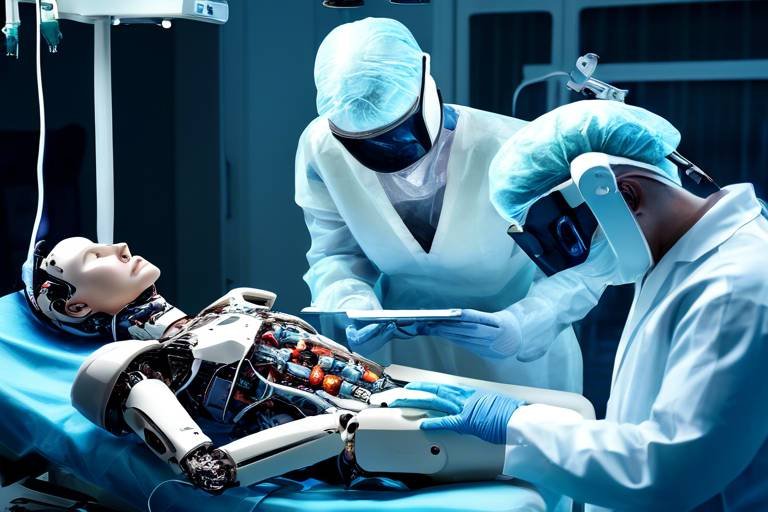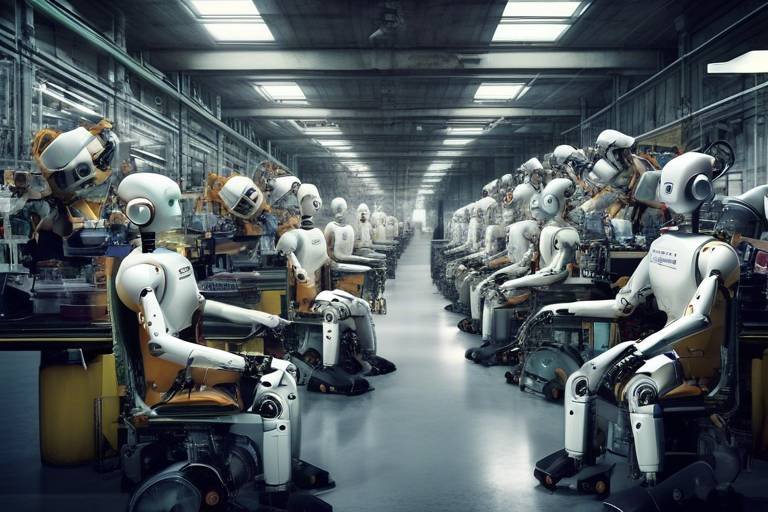How Robotics Will Change the Future of Surgery
The landscape of surgery is undergoing a monumental shift, thanks to the advent of robotics. Imagine a world where surgical precision is enhanced not just by the skill of the surgeon but also by advanced technology that can perform intricate movements with unparalleled accuracy. This is not science fiction; it’s the reality we are stepping into. Robotics in surgery is not merely a trend; it represents a fundamental change in how surgical procedures are performed, promising to improve outcomes and revolutionize patient care.
As we delve into this topic, we’ll explore the remarkable advancements that have paved the way for robotic surgery, the myriad benefits it brings to both patients and healthcare providers, and the challenges that still lie ahead. In doing so, we’ll uncover how robotics is set to redefine the future of surgery as we know it.
Recent technological innovations have significantly enhanced the capabilities of robotic surgery, enabling more precise, minimally invasive procedures that improve patient outcomes and recovery times. With robots now equipped with sophisticated instruments and high-definition cameras, surgeons can perform operations with a level of detail and accuracy that was previously unimaginable. These advancements have not only made surgeries safer but have also reduced the time patients spend in recovery.
Robotic-assisted surgeries offer numerous advantages, including reduced pain, shorter hospital stays, and enhanced surgical precision. Patients experience less trauma and quicker recoveries, leading to better overall satisfaction. Some key benefits include:
- Minimally Invasive Techniques: Smaller incisions mean less pain and quicker healing.
- Enhanced Visualization: 3D imaging allows surgeons to see the surgical site in greater detail.
- Precision and Control: Robots can execute delicate maneuvers that might be difficult for human hands.
Minimally invasive robotic techniques have transformed traditional surgery, allowing for smaller incisions, reduced blood loss, and quicker recovery, making them a preferred choice for various procedures. This approach not only minimizes the physical impact on the patient but also significantly lowers the risk of complications.
Robotic systems provide surgeons with superior visualization through 3D imaging and high-definition cameras, allowing for greater accuracy and improved decision-making during complex surgeries. This enhanced view is akin to putting on a pair of high-definition glasses; everything becomes clearer, leading to more informed choices in the operating room.
The precision and control offered by robotic systems enable surgeons to perform intricate movements that may be challenging with traditional methods. This level of control is essential for delicate procedures, such as neurosurgery or complex cardiac operations, where even the slightest miscalculation can have significant consequences.
As robotic surgery becomes more prevalent, there is a growing need for specialized training programs to equip surgeons with the necessary skills to operate robotic systems effectively. Just as a pilot must master flying a plane, surgeons must become adept at using these advanced technologies to ensure the best outcomes for their patients.
Despite its advantages, robotic surgery faces challenges such as high costs, limited access in some regions, and the need for extensive training, which can hinder widespread adoption. Overcoming these hurdles is crucial for the future of robotic-assisted surgery.
The high initial investment and maintenance costs of robotic systems can be a barrier for many healthcare facilities, impacting the accessibility of advanced surgical options for patients. This financial consideration is not just about purchasing the technology; it also involves ongoing training and support to ensure that the systems are used effectively.
Ensuring the safety and efficacy of robotic surgical systems is crucial, leading to ongoing regulatory scrutiny and the need for comprehensive clinical trials to validate their use. As with any new technology in healthcare, establishing trust and safety is paramount to encourage adoption.
Looking ahead, the future of robotics in surgery promises continued innovation, with advancements in artificial intelligence and machine learning poised to further enhance surgical capabilities and patient care. Imagine robots that not only assist but also learn from each procedure, becoming more adept over time. The integration of AI could lead to even greater precision, reduced risks, and a more personalized approach to surgical care.
- What types of surgeries can be performed using robotic systems?
Robotic systems can be used for a variety of procedures, including urological, gynecological, cardiac, and orthopedic surgeries.
- Are robotic surgeries safe?
Yes, robotic surgeries are generally considered safe, but like any surgical procedure, they come with risks. Comprehensive training and adherence to safety protocols are essential.
- How does robotic surgery benefit patients?
Patients benefit from reduced pain, shorter recovery times, and less scarring compared to traditional surgical methods.
- What is the cost of robotic surgery?
The cost can vary widely depending on the procedure and the healthcare facility, but it often includes both the use of the robotic system and the surgeon's expertise.

Advancements in Robotic Surgery
Recent technological innovations have significantly transformed the landscape of surgical practices, particularly through the advent of robotic surgery. These advancements have ushered in a new era of precision and efficiency, allowing surgeons to perform complex procedures with a level of accuracy that was previously unimaginable. Imagine a surgeon, equipped with robotic arms that can move with the finesse of a pianist's fingers, executing intricate movements while minimizing patient trauma. This is the reality of modern robotic surgery, where technology and human skill converge to enhance patient outcomes.
One of the most notable advancements is the development of minimally invasive techniques. Traditional surgical methods often required large incisions, leading to longer recovery times and increased risk of complications. However, robotic systems allow for smaller incisions, which not only reduce blood loss but also lead to quicker recovery times. For instance, in procedures such as laparoscopic surgeries, the use of robotic assistance has become a game-changer, enabling surgeons to navigate complex anatomical structures with ease.
Moreover, the integration of 3D imaging and high-definition cameras into robotic systems has revolutionized visualization during surgery. Surgeons can now view the surgical site in three dimensions, providing them with a detailed perspective that enhances their ability to make informed decisions. This superior visualization is akin to switching from a standard television to a high-definition screen; the clarity and detail allow for a more precise understanding of the surgical field.
In addition to enhanced visualization, the precision and control offered by robotic systems are unparalleled. Surgeons can execute delicate maneuvers that would be nearly impossible with traditional methods. For example, during a prostatectomy, robotic systems enable the surgeon to operate with pinpoint accuracy, significantly reducing the risk of nerve damage and improving postoperative outcomes. The ability to scale movements, where a surgeon's large hand movements translate into tiny, precise actions by the robotic instruments, is a remarkable feature that enhances the effectiveness of surgical procedures.
As we look to the future, the advancements in robotic surgery are not only limited to the operating room. The ongoing integration of artificial intelligence and machine learning into robotic systems is poised to further enhance surgical capabilities. Imagine robots that can learn from each procedure, adapting and optimizing their techniques over time. This potential for continuous improvement could lead to even better patient outcomes and lower complication rates.
In conclusion, the advancements in robotic surgery represent a significant leap forward in the field of medicine. By combining cutting-edge technology with skilled surgical practice, we are witnessing a transformation that promises to enhance patient care, reduce recovery times, and improve surgical outcomes. As we continue to explore the possibilities of robotics in surgery, the future looks incredibly promising.

Benefits of Robotic-Assisted Surgery
Robotic-assisted surgeries are revolutionizing the medical field, offering a plethora of benefits that traditional surgical methods simply can't match. Imagine a world where surgeries are not only more effective but also less painful—that's the reality we're stepping into. One of the most significant advantages of robotic surgery is the reduction in pain experienced by patients. With the use of advanced robotic systems, surgeons can perform procedures with remarkable precision, which often translates to smaller incisions. This means less trauma to the body and, consequently, a much smoother recovery process.
Another noteworthy benefit is the shorter hospital stays associated with robotic-assisted procedures. Patients who undergo these surgeries typically experience quicker recoveries, allowing them to return to the comfort of their homes in record time. This not only enhances patient satisfaction but also reduces the burden on healthcare facilities. In a world where hospital resources are often stretched thin, this is a game-changer.
Moreover, the enhanced surgical precision offered by robotic systems cannot be overstated. With the ability to make intricate movements that are difficult, if not impossible, with traditional methods, surgeons can navigate complex anatomical structures with ease. This increased control minimizes the risk of complications and leads to better overall outcomes. For instance, in delicate procedures, such as those involving the heart or brain, the ability to operate with such accuracy can be the difference between success and failure.
But the advantages don’t stop there. A recent study highlighted in the Journal of Robotic Surgery showed that patients who underwent robotic-assisted procedures experienced significantly less blood loss compared to those who had traditional surgeries. This reduction in blood loss not only enhances patient safety but also decreases the likelihood of needing blood transfusions, which can introduce additional risks.
To summarize, the benefits of robotic-assisted surgery can be encapsulated as follows:
- Reduced Pain: Smaller incisions lead to less trauma and discomfort.
- Shorter Hospital Stays: Patients recover faster and return home sooner.
- Enhanced Precision: Greater control allows for more intricate and safer procedures.
- Less Blood Loss: Minimally invasive techniques result in reduced blood loss and lower complication rates.
As we continue to embrace these technological advancements, it's clear that robotic-assisted surgery is not just a fleeting trend; it's a transformative force in the world of medicine. The combination of efficiency, effectiveness, and patient-centric care is paving the way for a future where surgery is safer and more accessible than ever before.
Q: What types of surgeries can be performed using robotic systems?
A: Robotic systems can assist in various surgeries, including urological, gynecological, and cardiac procedures, among others.
Q: Is robotic surgery safe?
A: Yes, robotic surgery is generally considered safe. However, as with any surgical procedure, it carries some risks. It's essential to discuss these with your surgeon.
Q: How does recovery from robotic surgery compare to traditional surgery?
A: Patients often experience quicker recovery times and less pain with robotic surgery compared to traditional methods, allowing them to return to their daily activities sooner.
Q: Are robotic surgeries more expensive?
A: While the initial costs of robotic systems can be high, the overall expenses may be offset by shorter hospital stays and reduced complications.

Minimally Invasive Techniques
Minimally invasive robotic techniques have completely transformed the landscape of traditional surgery, ushering in a new era where patients can experience less trauma and faster recoveries. Imagine undergoing a surgical procedure that requires only a few small incisions instead of a large open wound; this is the reality that robotic surgery brings to the table. By utilizing advanced robotic systems, surgeons can perform intricate operations with remarkable precision, resulting in less pain and quicker healing times for patients.
One of the standout features of these techniques is their ability to significantly reduce blood loss. Traditional surgeries often involve large cuts that can lead to considerable bleeding, but with robotic assistance, the incisions are so small that the body experiences minimal disruption. This not only aids in recovery but also lowers the risk of complications associated with blood loss. The magic lies in the robotic arms, which can maneuver with a level of finesse that human hands simply cannot match.
Furthermore, the benefits of minimally invasive techniques extend beyond just the surgical procedure itself. Patients who undergo these types of surgeries typically enjoy shorter hospital stays. This means they can return to the comfort of their homes sooner, which is crucial for emotional well-being and overall recovery. For many, the thought of spending less time in a hospital is a significant relief, alleviating anxiety and allowing them to focus on healing.
In addition to these advantages, the enhanced visualization provided by robotic systems is a game-changer. Surgeons can view the surgical site in high-definition 3D, allowing for greater accuracy in their movements. This level of detail is akin to having a superpower; it enables surgeons to see things that would be invisible to the naked eye during traditional procedures. This enhanced perspective not only boosts the surgeon's confidence but also leads to improved decision-making during complex operations.
Moreover, the precision and control offered by robotic systems can make a world of difference in delicate surgeries, such as those involving the heart or brain. The ability to execute intricate movements with pinpoint accuracy can mean the difference between a successful surgery and complications. Surgeons can now perform tasks that require a steady hand and fine motor skills with ease, which is especially beneficial in high-stakes situations.
Overall, the shift towards minimally invasive techniques in robotic surgery represents a significant leap forward in medical technology. As these methods become more prevalent, we can expect to see even more advancements that will further enhance patient outcomes and redefine the standards of surgical care.
- What are minimally invasive techniques? Minimally invasive techniques refer to surgical procedures that use small incisions, allowing for less trauma to the body and quicker recovery times.
- How does robotic surgery improve precision? Robotic systems provide surgeons with enhanced visualization and the ability to perform intricate movements with greater accuracy than traditional methods.
- What are the benefits of minimally invasive surgery? Benefits include reduced pain, shorter hospital stays, less blood loss, and quicker recovery times.
- Are there risks associated with robotic surgery? Like any surgical procedure, robotic surgery carries risks, but the minimally invasive nature often leads to fewer complications compared to traditional surgery.

Enhanced Visualization
When it comes to surgery, visual clarity is paramount. Imagine trying to thread a needle while wearing sunglasses—frustrating, right? That's where the magic of robotic systems comes into play. These advanced technologies provide surgeons with superior visualization that significantly enhances their ability to perform intricate procedures. Equipped with 3D imaging and high-definition cameras, robotic systems allow surgeons to see the surgical field in ways that traditional methods simply can't match.
With the ability to zoom in on specific areas and provide a three-dimensional view, surgeons can navigate through complex anatomical structures with remarkable precision. This enhanced visualization not only aids in the accuracy of the surgery but also boosts the surgeon's confidence. They can make informed decisions in real-time, reducing the risk of complications and improving patient outcomes.
Moreover, the depth perception offered by these robotic systems is a game changer. In traditional surgeries, depth perception may be compromised, leading to potential errors. However, with robotic-assisted visualization, surgeons can gauge distances accurately, making it easier to avoid critical structures and perform delicate maneuvers. This level of detail is especially crucial in surgeries involving sensitive areas, such as the brain or heart.
To illustrate the impact of enhanced visualization, consider the following table that compares traditional surgical visualization with robotic-assisted visualization:
| Aspect | Traditional Surgery | Robotic-Assisted Surgery |
|---|---|---|
| Image Quality | Standard 2D view | High-definition 3D view |
| Depth Perception | Limited | Enhanced |
| Field of View | Restricted | Wide-angle view |
| Real-time Feedback | Minimal | Immediate and detailed |
In conclusion, the enhanced visualization capabilities provided by robotic surgical systems represent a significant leap forward in surgical technology. As these advancements continue to evolve, we can expect even greater improvements in surgical precision and patient care. After all, when surgeons can see better, patients benefit from safer and more effective procedures.
- What is robotic surgery? Robotic surgery is a minimally invasive surgical technique that uses robotic systems to assist surgeons in performing complex procedures with enhanced precision.
- How does enhanced visualization improve surgical outcomes? Enhanced visualization allows surgeons to see the surgical site more clearly, aiding in accurate decision-making and reducing the risk of complications.
- Are there risks associated with robotic surgery? As with any surgical procedure, there are risks, but robotic surgery generally offers a lower risk of complications compared to traditional methods.
- What types of surgeries can be performed using robotic systems? Robotic systems can be used in various surgical specialties, including urology, gynecology, and cardiothoracic surgery.

Precision and Control
When it comes to surgery, precision and control are not just nice-to-haves; they are absolutely essential. Imagine trying to thread a needle while wearing thick gloves—it's tricky, right? This is where robotic systems shine. They offer surgeons a level of precision that traditional methods simply can't match. With robotic-assisted surgery, surgeons can perform intricate movements with a level of accuracy that minimizes the risk of complications and enhances patient outcomes.
Robotic systems are designed with advanced technology that translates a surgeon's hand movements into smaller, more precise motions of surgical instruments. This means that even the most delicate procedures can be executed with a level of finesse that is often impossible with the human hand alone. For example, during a prostatectomy, a surgeon can navigate around sensitive nerves with remarkable precision, significantly reducing the risk of damage.
Additionally, the robotic arms are equipped with a range of tools that can rotate and move in ways that human hands cannot. This enhanced control allows for a greater range of motion and the ability to access hard-to-reach areas within the body. Surgeons can manipulate instruments with a 360-degree range of motion, enabling them to perform complex tasks without the need for large incisions. As a result, patients experience less trauma and quicker recovery times.
Furthermore, the integration of high-definition cameras and 3D visualization technology into robotic systems provides surgeons with an unparalleled view of the surgical site. This advanced visualization helps in making informed decisions during surgery, ensuring that every movement is calculated and deliberate. In a way, it's like having a superpower—surgeons can see and act with clarity, which is crucial for successful outcomes.
In summary, the precision and control offered by robotic systems are game-changers in the field of surgery. They not only enhance the surgeon's capabilities but also significantly improve patient safety and recovery. As technology continues to evolve, we can expect even greater advancements in this arena, making surgery less invasive and more effective than ever before.
- What are the main benefits of robotic surgery? Robotic surgery offers benefits such as reduced pain, shorter recovery times, and enhanced precision.
- Are there risks associated with robotic surgery? Like any surgical procedure, there are risks, but robotic systems can minimize complications through greater precision.
- How long does it take to recover from robotic surgery? Recovery times vary by procedure, but many patients experience quicker recoveries compared to traditional surgery.
- Is robotic surgery available for all types of procedures? While robotic surgery is expanding, not all procedures are suitable for this approach. It's best to consult with a healthcare provider.

Training and Skill Development
As robotic surgery continues to gain traction in the medical field, the importance of for surgeons cannot be overstated. The intricate nature of robotic systems requires a new set of skills that traditional surgical training may not fully encompass. Surgeons must not only master the mechanics of operating robotic instruments, but they also need to develop a deep understanding of the technology that powers these systems. This transition from conventional methods to robotic-assisted procedures is akin to learning to drive a car after years of riding a bicycle; both require coordination and precision, but the tools and techniques are vastly different.
To address this need, many medical institutions are now implementing specialized training programs designed to equip surgeons with the necessary expertise to navigate robotic systems effectively. These programs often include a combination of theoretical education and practical, hands-on experience. For instance, surgeons might engage in simulation training, where they can practice procedures in a risk-free environment. This allows them to familiarize themselves with the robotic interface and develop their skills before operating on real patients.
Moreover, ongoing education is crucial as technology evolves. Surgeons must stay updated with the latest advancements in robotic surgery, which can include new techniques, software updates, and enhancements in robotic capabilities. Many hospitals are now offering continuing education courses and workshops to ensure that their surgical teams remain at the forefront of this rapidly changing field.
In addition to formal training, mentorship plays a vital role in skill development. Experienced robotic surgeons can provide invaluable insights and guidance to their less experienced colleagues. This collaborative learning environment fosters a culture of knowledge sharing, where novice surgeons can learn from the successes and challenges faced by their mentors. Ultimately, the integration of comprehensive training programs, simulation exercises, and mentorship can significantly enhance the proficiency of surgeons in robotic-assisted procedures.
As we look to the future, the emphasis on training and skill development will only intensify. With advancements in artificial intelligence and robotics, the complexity of surgical procedures is likely to increase, necessitating even more specialized training. Institutions that prioritize these educational initiatives will not only improve surgical outcomes but also ensure that their teams are well-prepared to embrace the future of surgery.
- What is robotic surgery? Robotic surgery involves the use of robotic systems to assist surgeons in performing minimally invasive procedures with enhanced precision and control.
- How long does it take to train for robotic surgery? Training duration can vary, but many programs offer intensive training over several months, followed by ongoing education and practice.
- Are there risks associated with robotic surgery? As with any surgical procedure, there are risks involved, but robotic surgery generally has a lower complication rate compared to traditional methods.
- What are the benefits of robotic-assisted surgery? Benefits include reduced pain, shorter hospital stays, enhanced precision, and quicker recovery times, leading to improved patient satisfaction.

Challenges in Robotic Surgery
While robotic surgery is undeniably paving the way for a new era in medical procedures, it is not without its challenges. One of the most significant hurdles faced by this innovative technology is the high cost associated with robotic surgical systems. The initial investment for purchasing these sophisticated machines can run into millions of dollars, which can be a daunting figure for many healthcare facilities, especially smaller hospitals and clinics. This financial burden often leads to limited availability of robotic surgery options for patients, creating a disparity in access to advanced treatment methods.
Moreover, the ongoing maintenance costs of robotic systems can also be substantial. Facilities must budget for regular updates, repairs, and training for their surgical teams, which can further strain their financial resources. This results in a situation where only larger, well-funded medical institutions can afford to implement robotic surgery, leaving many patients without access to these cutting-edge technologies.
In addition to financial barriers, there are also regulatory and safety concerns that need to be addressed. As with any new technology, ensuring the safety and efficacy of robotic surgical systems is paramount. Regulatory bodies closely scrutinize these systems, requiring extensive clinical trials to validate their use and effectiveness. This can lead to delays in the adoption of robotic surgery, as hospitals and clinics must wait for approvals before they can integrate these systems into their practices.
Furthermore, the complexity of robotic systems necessitates a high level of specialized training for surgeons. As robotic surgery becomes more prevalent, there is a growing need for comprehensive training programs to equip medical professionals with the necessary skills to operate these advanced machines effectively. This training can be time-consuming and costly, adding another layer of challenge to the widespread implementation of robotic surgery.
In summary, while the benefits of robotic surgery are compelling, the challenges it faces cannot be overlooked. The high costs, regulatory hurdles, and need for specialized training create a multifaceted landscape that must be navigated carefully. As the field continues to evolve, addressing these challenges will be crucial in ensuring that robotic surgery can reach its full potential and become a standard practice in healthcare.
- What are the main benefits of robotic surgery? Robotic surgery offers numerous advantages, including enhanced precision, reduced recovery time, and less postoperative pain.
- Are there risks associated with robotic surgery? Like any surgical procedure, there are risks involved, but robotic surgery generally has a lower complication rate compared to traditional methods.
- How long does it take to train a surgeon in robotic surgery? Training can vary, but it typically involves several months of specialized instruction and hands-on practice.
- Is robotic surgery available everywhere? Unfortunately, access can be limited, especially in rural or underfunded healthcare facilities.

Cost Implications
The introduction of robotic surgery into healthcare has undeniably brought about a revolution in surgical practices, but it has also introduced a set of that cannot be overlooked. First and foremost, the initial investment required to acquire robotic surgical systems can be staggering. Hospitals and surgical centers often face costs that can range from $1 million to over $2 million for a single robotic unit, not to mention the expenses associated with installation, maintenance, and ongoing operational costs. This financial burden can be a significant barrier, particularly for smaller healthcare facilities or those in economically challenged regions.
Moreover, the costs extend beyond just the equipment. Training surgeons and operating room staff to effectively use these advanced systems is crucial, yet it adds another layer of expense. Comprehensive training programs can be costly and time-consuming, often requiring surgeons to attend specialized courses or workshops, which may involve travel and accommodation expenses. The need for continuous education in this rapidly evolving field further compounds these costs, as technology advances and new systems are developed.
In addition to direct costs, there are also indirect costs to consider. For example, the integration of robotic systems into surgical workflows can lead to temporary disruptions in existing operations, resulting in lost revenue during the transition period. Facilities must also account for the potential need for additional staff to manage the new technology, which can further inflate operational costs.
To illustrate the financial landscape surrounding robotic surgery, consider the following table that outlines some of the key cost factors:
| Cost Factor | Estimated Cost |
|---|---|
| Initial Equipment Purchase | $1 million - $2 million |
| Training Programs | $10,000 - $50,000 per surgeon |
| Maintenance Costs | $100,000 annually |
| Operational Disruption | Variable (depends on transition time) |
Despite these challenges, many healthcare facilities are recognizing the long-term benefits of robotic surgery, which can lead to improved patient outcomes and potentially lower costs associated with complications and readmissions. As the technology continues to advance and become more widely adopted, it is possible that the costs associated with robotic surgery will decrease, making it a more accessible option for a broader range of patients.
- What are the main costs associated with robotic surgery? The main costs include the initial purchase of the robotic system, training for surgeons, maintenance, and potential operational disruptions.
- Are robotic surgeries more expensive than traditional surgeries? Initially, yes, but they can lead to better outcomes and shorter recovery times, which may offset costs in the long run.
- How can hospitals manage the high costs of robotic surgery? Hospitals can seek partnerships, grants, and funding opportunities, as well as invest in training programs that maximize the use of robotic systems.

Regulatory and Safety Concerns
As the field of robotic surgery continues to evolve, have emerged as critical issues that must be addressed to ensure the technology is both effective and safe for patients. The integration of robotic systems into surgical practices is not merely a matter of innovation; it also involves navigating a complex landscape of regulations designed to protect patient safety. Regulatory bodies, such as the FDA in the United States, play a pivotal role in evaluating the safety and efficacy of these advanced surgical systems before they can be widely adopted in clinical settings.
One of the primary challenges is the need for comprehensive clinical trials. These trials are essential to demonstrate that robotic systems can perform their intended functions without compromising patient safety. The rigorous testing process helps identify potential risks and ensures that the devices meet the necessary standards. However, the lengthy duration and high costs associated with these trials can delay the introduction of beneficial technologies into the market, ultimately affecting patient access to advanced surgical options.
Moreover, surgeons must be trained adequately to operate these robotic systems. Without proper training, the risk of complications during surgery increases. This highlights the importance of establishing standardized training programs that can equip surgeons with the skills needed to navigate the complexities of robotic-assisted procedures. Furthermore, ongoing education is crucial, as technology and techniques continue to advance rapidly.
In addition to training, there are also concerns about device malfunction. Just like any other piece of technology, robotic systems can fail, which could potentially lead to severe consequences during surgery. This underscores the importance of regular maintenance and updates to the software and hardware of these systems. Healthcare facilities must ensure that they have protocols in place for routine checks and that their staff is trained to handle any unexpected issues that may arise during a procedure.
Another significant aspect of regulatory concern is the transparency of data. As robotic surgeries become more prevalent, it is essential to collect and analyze data on their outcomes. This information not only helps in refining surgical techniques but also supports regulatory bodies in making informed decisions about the approval and regulation of these systems. Transparency in reporting outcomes can enhance trust among patients and healthcare providers alike.
In conclusion, while the promise of robotic surgery is immense, navigating the regulatory landscape and addressing safety concerns remains a top priority. By ensuring rigorous testing, comprehensive training, and transparency, the medical community can harness the full potential of robotic systems while safeguarding patient health.
- What are the main benefits of robotic surgery? Robotic surgery offers benefits such as reduced pain, shorter recovery times, and enhanced precision during procedures.
- Are there risks associated with robotic surgery? Yes, like any surgical procedure, robotic surgery carries risks, including potential device malfunction and the need for skilled operators.
- How are surgeons trained to use robotic systems? Surgeons undergo specialized training programs that include simulations and hands-on experience with robotic systems to ensure they are adequately prepared.
- What regulatory bodies oversee robotic surgery? In the United States, the FDA is responsible for evaluating the safety and efficacy of robotic surgical systems before they can be used in clinical settings.
- Is robotic surgery accessible to all patients? Accessibility can vary based on the healthcare facility, location, and the costs associated with robotic systems, which can be significant.

The Future of Robotics in Surgery
The future of robotics in surgery is not just bright; it's positively dazzling! As we look ahead, we can expect a wave of innovations that will further revolutionize surgical practices. Imagine a world where artificial intelligence and machine learning seamlessly integrate with robotic systems, making surgeries not only more efficient but also safer and more personalized. This is not science fiction; it's the trajectory we're heading toward. With the rapid pace of technological advancements, we are on the brink of a new era in medicine where robots could assist in complex procedures with unparalleled precision and insight.
One of the most exciting prospects is the development of autonomous surgical robots. These machines will be equipped with advanced algorithms that allow them to make real-time decisions during surgery. Think of it as having a co-pilot who can take over the controls when necessary, ensuring that the surgery proceeds smoothly even in unpredictable situations. This could significantly reduce the stress and cognitive load on surgeons, allowing them to focus on more complex aspects of the procedure.
Moreover, the incorporation of tele-surgery is set to change the landscape of healthcare delivery. Surgeons will be able to operate remotely, using robotic systems to perform surgeries on patients located in different parts of the world. This could bridge the gap in healthcare access, especially in under-served regions where specialized surgical expertise is scarce. Imagine a renowned surgeon in New York performing a delicate operation on a patient in a rural clinic in Africa—all thanks to the power of robotics and high-speed internet!
As we delve deeper into the future, we must also consider the importance of data analytics. The vast amounts of data generated during robotic surgeries can be harnessed to improve surgical techniques and patient outcomes. By analyzing patterns and outcomes, we can refine procedures, reduce complications, and enhance recovery times. This data-driven approach will not only benefit individual patients but also contribute to the overall body of medical knowledge, paving the way for further innovations.
However, with great power comes great responsibility. As we embrace these advancements, we must remain vigilant about the ethical implications of robotic surgery. Questions around patient consent, data privacy, and the role of human oversight in automated procedures are critical discussions that need to take place. We must ensure that as we innovate, we do not compromise on the core values of patient care and safety.
In conclusion, the future of robotics in surgery is filled with potential and promise. With advancements in technology, training, and ethical considerations, we are poised to enter a new era of surgical excellence. The integration of artificial intelligence, remote operations, and data analytics will not only enhance surgical precision but also improve patient experiences and outcomes. As we navigate this exciting frontier, one thing is clear: the future of surgery is robotic, and it's going to be an incredible journey!
- What are the main advantages of robotic surgery?
Robotic surgery offers numerous benefits, including enhanced precision, reduced recovery times, and minimal invasiveness, which leads to less pain and scarring for patients. - Are there any risks associated with robotic surgery?
As with any surgical procedure, there are risks involved. However, robotic systems are designed to enhance surgical accuracy, which can help mitigate some of these risks. - How does training for robotic surgery work?
Surgeons typically undergo specialized training programs that include simulations and hands-on practice with robotic systems to develop their skills before performing actual surgeries. - Will robotic surgery become more accessible in the future?
As technology advances and costs decrease, it is expected that robotic surgery will become more widely available, especially in regions that currently lack access to such advanced surgical options.
Frequently Asked Questions
- What is robotic surgery?
Robotic surgery is a minimally invasive surgical technique that utilizes robotic systems to assist surgeons in performing complex procedures with enhanced precision and control. These systems often feature high-definition cameras and robotic arms that allow for intricate movements and better visualization during surgery.
- What are the benefits of robotic-assisted surgery?
Robotic-assisted surgery offers several advantages, including reduced pain, shorter hospital stays, and quicker recovery times. Patients often experience less blood loss and smaller incisions, which contribute to improved overall satisfaction and outcomes.
- Are there any risks associated with robotic surgery?
Like any surgical procedure, robotic surgery carries certain risks. These can include complications related to anesthesia, infection, or issues specific to the robotic system. However, when performed by trained professionals, the benefits often outweigh the risks.
- How is a surgeon trained for robotic surgery?
Surgeons undergo specialized training programs that focus on operating robotic systems effectively. This training typically includes simulation exercises, hands-on practice, and mentorship from experienced robotic surgeons to ensure they are well-prepared for real-life procedures.
- What are the challenges facing robotic surgery?
Some challenges include high costs associated with robotic systems, limited access in certain regions, and the need for extensive training for surgeons. These factors can hinder the widespread adoption of robotic surgery in healthcare facilities.
- How does robotic surgery improve surgical precision?
Robotic systems enhance surgical precision through advanced technology that allows for more accurate movements than the human hand can achieve. Surgeons can perform delicate tasks with greater control, reducing the risk of errors during complex procedures.
- What does the future hold for robotics in surgery?
The future of robotics in surgery looks promising, with ongoing advancements in artificial intelligence and machine learning expected to further enhance surgical capabilities. These innovations may lead to even more efficient and effective surgical procedures, improving patient care overall.


















